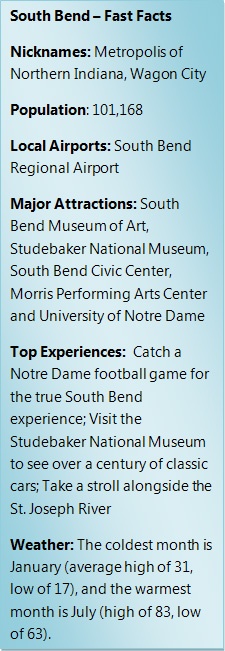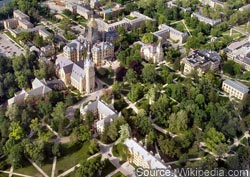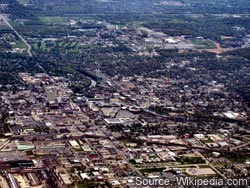 South Bend is the fourth largest city in the state of Indiana and the county seat of St. Joseph County. The city's unique name is derived from its location on the St. Joseph River's south bend and its close proximity to Michigan and Illinois have made it an economic and cultural hub for the Michiana region, which is the name given to the region that lies in northern Indiana and southern Michigan. The city offers an array of entertainment options for residents and visitors alike.
South Bend is the fourth largest city in the state of Indiana and the county seat of St. Joseph County. The city's unique name is derived from its location on the St. Joseph River's south bend and its close proximity to Michigan and Illinois have made it an economic and cultural hub for the Michiana region, which is the name given to the region that lies in northern Indiana and southern Michigan. The city offers an array of entertainment options for residents and visitors alike.
The city was founded by fur traders in the early part of the 19th century, and its population reached its peak in 1960 when there were over 132,000 people living in South Bend. The population has declined in the last few decades, mainly due to people migrating to suburban areas with lower property taxes. The staple of South Bend, Indiana, and what it's most known for by people around the country, is the University of Notre Dame, which is located just to the north of the city. On Saturdays in the fall, Notre Dame Football dominates the region.
This guide will provide you with some helpful tips and information on just about everything you need to know if you're going to be making the move to South Bend. From the city's neighborhoods and school systems to the employment options and recreational activities available within the city, you'll find it all in this guide so that you can go into your move with the knowledge that is needed to make sure everything goes as smoothly as possible.
South Bend Climate
The South Bend climate is a typical Midwestern humid continental climate with warm summers and cold winters, which is found extensively throughout the state of Indiana. While the fall and spring seasons can be stormy at times, they are mostly mild.
Summers and winters are known for extreme temperatures and July and August are typically the hottest months of the year. The range of lake effect snow from Lake Michigan plays a major part in the cold winters in South Bend and the lake has a large impact on the weather in the region.
Although, Indiana is ranked sixth among the tornado-prone states in the country, it is not a part of tornado alley. Geographically, the state consists of the central lowlands and the interior low plateau.
South Bend Neighborhoods
The city of South Bend is located equidistant from both Illinois and Ohio and is only five miles away from the Michigan border. This location is ideal for several reasons, including the facilitation of interstate commerce, and it's led to the city's growth and eventual status as an economic and cultural hub for the state of Indiana and the surrounding areas. South Bend is also only 93 miles from the city of Chicago, and the nearest shore of Lake Michigan is only 20 miles away.
As for the layout of the city, the St. Joseph River flows through the city from the east end and turns north near the city's center. Downtown South Bend is located in the northern part of the city right along the banks of the river, with mainly manufacturing and distribution facilities located on the west side of the city.
Living Costs in the City
While property taxes have certainly gone up over the years, leading to a significant drop in population since the 1960s, the living costs in South Bend are still well below the national average, and the median family income as of 2011 was $46,081. Also, the real estate prices are extremely low compared to the national average, with a median home price of only $75,000.
 The cost of living is fairly low in South Bend, compared to other major cities, however this is characteristic of many moderately-sized Midwestern cities. In fact, in 2012 Kiplinger Personal Finance placed South Bend on its list of "Ten Best Cities for Cheapskates." When compared to the national average job growth of24.63 percent, South Bend's job market has been considerably behind the rest of the country, despite the diverse economic base of the region and the city. With a job growth rate of -8.23 percent, the job growth is slower than the national average, and it may be a smart idea to secure employment before making your move to South Bend.
The cost of living is fairly low in South Bend, compared to other major cities, however this is characteristic of many moderately-sized Midwestern cities. In fact, in 2012 Kiplinger Personal Finance placed South Bend on its list of "Ten Best Cities for Cheapskates." When compared to the national average job growth of24.63 percent, South Bend's job market has been considerably behind the rest of the country, despite the diverse economic base of the region and the city. With a job growth rate of -8.23 percent, the job growth is slower than the national average, and it may be a smart idea to secure employment before making your move to South Bend.
Registering Your Car
You have 60 days to register your car in Indiana from the date of the beginning of your residency in the state of Indiana. For registering your vehicle, proof of your residency in the state and proof of your Social Security number should be submitted at a BMV office. Vehicle Inspection Number inspection by a law enforcement officer or at any local license office is also required.
A driver's license should be obtained within 60 days of becoming a resident of the state of Indiana. You are required to surrender your valid out of state driver's license before applying for an Indiana state license. If you do not have a valid out of state driver's license, then you are required to get an Indiana's learner permit for 180 days, before you can apply for the state's license.
South Bend Moving Resources
Moving and storage companies are ready and willing to help you with your move to South Bend, whether you're moving from out of state or from another county in Indiana. Make sure you get estimates from multiple moving services before you commit to hiring any (at least three estimates). Check back to our guides for tips on how to choose your moving service wisely with important questions to ask, differentiating between types of estimates, and mistakes to avoid. Visit the following pages at Movers.com to get quotes for the following services:
South Bend Schools
The public school system in South Bend is operated by the South Bend Community School Corporation, which oversees 17 elementary schools grades K-4, nine middle schools grades 5-8 and four public high schools. In total, the school district serves over 22,000 South Bend students. There are also several private schools located in the city, as well as 11 Catholic schools operated by the Diocese of Fort Wayne-South Bend.
There are several notable institutions of higher education located in and around the South Bend area. Some of these include the University of Notre Dame, Saint Mary's College, Holy Cross College, Indiana University South Bend, a campus of Purdue University and Brown Mackie College. Notre Dame is the biggest and most well-known university in the area and over the years it has had an enormous influence on the region and its culture and economy.
South Bend Employment
 The major financial strengths for the city of South Bend are the education sector and the healthcare sector. The University of Notre Dame is the largest employer in all of St. Joseph County, employing almost 5,000 people. Memorial Health System is also one of the largest employers of South Bend. With its location on the St. Joseph River, South Bend grew mainly as an industrial-based economy in the late 19th and early 20th centuries, however that industry began to diminish after World War II and many of the industrial buildings around the city still lay abandoned.
The major financial strengths for the city of South Bend are the education sector and the healthcare sector. The University of Notre Dame is the largest employer in all of St. Joseph County, employing almost 5,000 people. Memorial Health System is also one of the largest employers of South Bend. With its location on the St. Joseph River, South Bend grew mainly as an industrial-based economy in the late 19th and early 20th centuries, however that industry began to diminish after World War II and many of the industrial buildings around the city still lay abandoned.
Instead, new industries sprouted in its place, including health care, education and small business. Some of the notable businesses in the city include Honeywell, Bosch, AM General, Crowe Horwath and Martin's Supermarkets.
Public Transportation
South Bend has a number of important roads that connect the South Bend area to surrounding areas in Illinois, Indiana and Michigan like Indiana State Route 2, 23 and 933, U.S. Highway 20 and 31, and Interstate 80 and 90. The airport that provides service to South Bend is the South Bend Regional Airport, which connects passengers to larger hubs like Chicago O'Hare, Cleveland, Detroit and Minneapolis, among others.
The public transportation system is run by the South Bend Public Transportation Corporation (TRANSPO) which operates several bus routes within the city and the neighboring towns of Mishawaka, Osceola and Roseland. There is also an Amtrak station located in South Bend providing service to cities like Chicago, New York, Boston and Washington D.C. on two separate lines.
Culture and Contemporary Life
There are several annual festivals that take place in South Bend, including the South Bend Reggae Music Festival which showcases a stellar lineup of international reggae musicians and takes places each summer. Other events include the World Pulse Festival, which is a contemporary Christian music festival, and the Annual All Day Country Concert, typically held in the month of September.
There are plenty of other things to do in South Bend when festivals aren't happening though. Like visiting the South Bend Museum of Art, which features over 850 different works, or the Studebaker National Museum, with over 150 years worth of wagons and automobiles manufactured by Studebaker, a company that had their main plant located in South Bend. The Morris Performing Arts Center and the South Bend Civic Theater are also notable places to visit if you're into contemporary performing arts or classical music.
Moving to South Bend
Whatever your reasons for moving to South Bend, whether it be for a change of scenery or for employment, the city beckons you with its charm. The first step in the process of moving to South Bend is choosing a moving company after first checking their BBB ratings, insurance and license. The moving rates are charged by the hour if you are moving within the state boundary, while for a long distance move the charges will depend on the total weight or volume in cubic feet of your belongings. In the latter case, you can ask about a flat rate or any special discounts that are available with the mover.